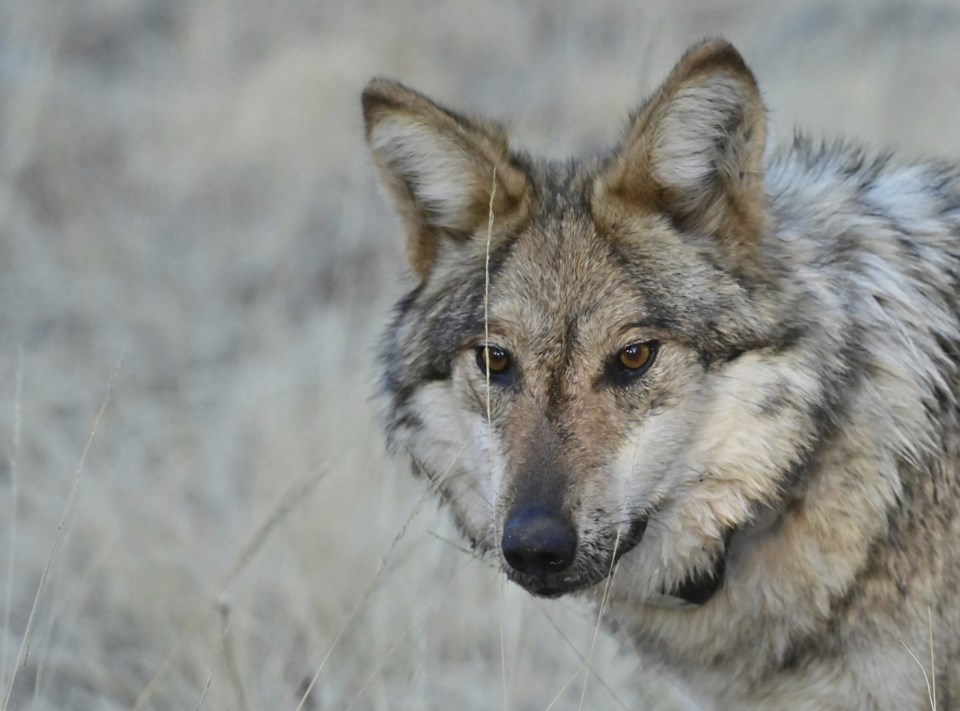ALBUQUERQUE, N.M. (AP) — Commissioners in a rural New Mexico county say pets are being snatched from front yards and livestock are being maimed and killed by endangered Mexican gray wolves that seem to have no fear of humans, prompting them to declare a state of emergency.
In the latest flash point over efforts to reintroduce wolves into the western U.S., Catron County commissioners heard nearly three hours of testimony Thursday from frustrated ranchers and concerned rural residents — some of whom traveled from Arizona to attend the packed meeting. Dozens more joined online, including environmentalists and state and federal officials.
"For us, for the people in this room, wolves are not some romanticized concept. ... For those of us on the ground, they’re a very real daily threat,” said Tom Paterson, a rancher and president-elect of the New Mexico Cattle Growers' Association. He's worried about his grandson playing on the deck, just 100 yards (90 meters) from where wolves killed a steer in February.
County commissioners issued a warning to residents last week to be aware of their surroundings when outdoors and maintain constant supervision of children and pets.
The concerns stretch beyond New Mexico, as officials in parts of Oregon and Northern California say gray wolves — the larger, more common cousins of Mexican gray wolves — seem brazen and are killing more livestock. Two California counties declared emergencies in recent weeks and the sheriff in another requested help from state wildlife officials.
Ranchers in New Mexico and Arizona have been at odds with the reintroduction of Mexican gray wolves since the first release in the late 1990s. Despite limited programs for reimbursing certain losses, ranchers say wolves pose a threat to their way of life, which is already challenged by prolonged drought and rising prices.
Environmentalists argue that Mexican wolves should have a place in the Southwest, often criticizing the U.S. Fish and Wildlife Service for not releasing more captive wolves to ensure genetic diversity among the wild population. They contend there’s no incident in recorded history of a Mexican wolf attacking or injuring a person.
While fatal attacks are rare in North America, Catron County Sheriff Keith Hughes said there's danger in not removing Mexican wolves that frequent developed areas. He said one was spotted Wednesday in the community of Reserve.
There are at least 286 Mexican wolves in Arizona and New Mexico, but federal officials acknowledged Thursday that they don't know how many actually are on the landscape. They also say livestock kills are decreasing, with 100 confirmed in 2024. Ranchers argue that for every confirmed kill, there are likely five more where investigators don’t have enough evidence left to add them to the list or the animals are never found.
Wildlife managers conducted 290 successful hazing operations last year to scare wolves away from rural homes and livestock, and the Fish and Wildlife Service reiterated its commitment Thursday to minimizing conflicts and reducing the economic effects on ranchers.
In the resolution, Catron County states the culture and customs of residents have been compromised by the reintroduction of Mexican wolves. It requests emergency financial aid from the state and asks the governor to order the New Mexico National Guard into service to support county authorities as needed.
Democratic Gov. Michelle Lujan Grisham's office has not returned messages from The Associated Press on whether she supports the declaration.
In Oregon, ranchers in Lake County said they were forced to hire extra workers to patrol their herds around the clock because of issues with gray wolves there. Some bought night vision goggles to help with the task. That county commission declared an emergency in February, and wildlife managers ended up killing a wolf after nonlethal means failed to stop it.
California's Sierra County declared an emergency Tuesday, following similar action by Modoc County in mid-March. Neighboring Lassen County also has reported increased gray wolf activity.
In Colorado, a group is gathering petition signatures in hopes of putting the question of wolf reintroductions to voters through a ballot initiative in 2026. Federal wildlife managers recently killed a collared wolf that appeared to have crossed into Wyoming and killed several sheep.
In Montana, lawmakers are considering legislation to extend the wolf hunting season, while wildlife managers in Idaho allow limited trapping and snaring to manage the population there.
Disputes over management of both gray wolves and Mexican wolves have fueled legal and legislative battles for years. In the Southwest, the fate of a management rule and the boundaries of the recovery area are pending before a federal appeals court.
Susan Montoya Bryan, The Associated Press


